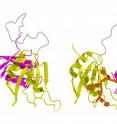New mechanism in the regulation of human genes
Scientists at the Technical University of Munich and the Helmholtz Zentrum Muenchen and along with their colleagues from the European Molecular Biology Laboratory (EMBL) in Heidelberg and the Centre for Genomic Regulation in Barcelona have discovered how the U2AF protein enables the pre-mRNA* to be spliced to form the mRNA*, which serves as a template for protein synthesis in the body. Splicing requires the cooperation of different proteins, i.e. splicing factors. One such splicing factor, U2AF, was examined by the Munich scientists. It consists of two structural modules and binds to the RNA near the intron*-exon* boundary. Professor Michael Sattler, Director of the Institute for Structural Biology at the Helmholtz Zentrum Muenchen and Professor of Biomolecular NMR Spectroscopy at the Technische Universitaet Muenchen, summarizes how the U2AF protein contributes towards splicing: "The spatial structure of the U2AF protein alternates between a closed and an open conformation. A matching RNA sequence in the intron causes the U2AF to assume an open conformation, which activates splicing and eventually leads to the removal of the intron."
The intron's RNA sequence determines how effectively this conformational change can be triggered. This shift of balance between the closed and the open form of the U2AF protein occurs through a process of conformational selection, i.e. the RNA binds to a small fraction of the open conformation that already exists even in the absence of RNA. The scientists presume that similar mechanisms – balanced between a closed, inactive and an open, active conformation – play an important role in the regulation of many other signal pathways in the cell.
Background:
The genes in the human genome have a specific structure. Sections with relevant exons alternate with regions known as introns, which contain irrelevant information that does not encode the corresponding protein. In order for a protein to be produced, pre-messenger RNA (pre-mRNA) first has to be transcribed from the DNA. The pre-mRNA copy is then spliced and the introns are removed, leaving the mRNA; which consists solely of exons. Splicing requires that the introns recognized and accurately excised. Splicing is thus an essential process in the central dogma of molecular biology: genetic information flows in one direction: from the DNA to RNA to proteins.
Genome / gene / DNA / mRNA: Genes are the basis for the synthesis of proteins. In the first step, desoxyribonucleic acid (DNA) is transcribed to form a messenger ribonucleic acid (messenger RNA or mRNA), which in turn provides a template for protein synthesis. An organism's complete set of DNA is known as a genome.
Splicing / exons / introns / (pre-) mRNA: Exons are the DNA sections that encode the amino acid sequence of a given protein. The introns, which lie between the exons, are removed in the splicing process. The pre-mRNA thus is processed to a more mature mRNA.
Source: Technische Universitaet Muenchen
Other sources
- New mechanism in the regulation of human genesfrom PhysorgThu, 14 Jul 2011, 15:00:31 UTC
- New mechanism in the regulation of human genesfrom Science DailyThu, 14 Jul 2011, 13:30:35 UTC
